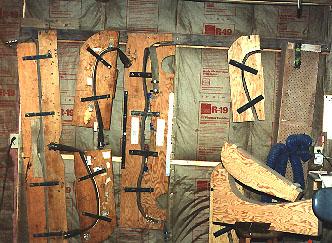LAMINATED BOW FORMS
Some decisions have to be made and several projects finished before actual
bow construction can begin. You have to decide, first off, what style of bow is
to be made. Longbows of any design, such as deflex/reflex, straight or reflex,
and one piece recurves all go together basically the same, so that choice is
personal preference. However, longbows are easier to successfully construct for
the first time bowyer because good limb alignment is simpler to achieve
The first project is to construct a bow form. Bow forms are usually made
from appropriate sized pieces of plywood, laminated together to the correct
thickness. Longbow forms are usually 1 1/2" thick and recurve forms are 1
3/4" or 2" thick. To achieve the longbow thickness, 2 pieces of 3/4"
plywood glued together will get the desired results. The correct thickness for 1
3/4" recurve forms can be obtained with 2 - 3/4" pieces of plywood
with 2 pieces of 1/8" masonite sandwiched between them. Sandwiching a 1/2"
piece of plywood along with a piece of masonite is what is needed to make the 2"
form. The following are approximate dimensions for longbow and recurve forms.
68" and shorter longbows: 72"
x 14" x 1 1/2"
60" one piece recurve: 64"
x 16" 2" (or 1 3/4")
After the bow form blank is finished, the next step is to transfer your bow
design to the side of the blank and then carefully cut it out using a bandsaw.
One technique that works well is to make your bow form blank in two equal
pieces. Stack the two halves together, solidly holding them together with wooded
plates along the edges. (See photo) Transfer half of your bow pattern to the
connected plywood blanks and cut out both halves of the form at the same time.
The halves are then butted together to complete the finished form. Using this
technique, both the upper and lower limbs are cut exactly the same. The junction
of the halves are strengthened using metal plates and angle iron.
The following photo shows several different bow forms. Starting from
left to right:

Straight longbow form: This form has
an interchangeable riser section, which allows different riser configurations to
be used.
Takedown recurve forms: These forms
were cut out simultaneously, using the previously mentioned technique, to insure
limb uniformity.
One piece recurve form: Both halves of
the this form were also cut out at one time and then butted together to create
the full length form. Note the metal plates and angle iron used to strengthen
the form. Both sides of the form are plated.
The upper right form is a youth takedown recurve
form.
The lower right form sitting on the stool is two
take-down recurve blanks temporarily laminated together and cut out.
(Note the wood block on the edges.) They will eventually be seperated and made
into forms that are exactly the same.
Its important that the form is square to its sides along its full length.
Any place where it is out of square will result in limb twist. Simply by using a
tri-square and checking the form, these areas can be trued up by careful sanding
and filing.
Both the top and bottom form will be connected using 10" pieces of flat
iron and 5/16" bolts of the appropriate length. The top half of the form
will have to be sawed again to allow enough space for the laminations and air
hose. Its important to leave the correct amount of space between the top and
bottom forms. Not enough space will prevent the two halves from being bolted
together when the laminations and hose are in place. Too much space will allow
the hose to become too circular, which can cause cupping of the bow limbs. The
following illustration will show the correct and incorrect configuration.
Normally the correct space will be from 1" to 1 1/4", depending on the
number of laminations used. 3/16" to 1/4" spacers should be used under
the connecting straps to allow the hose some room to expand laterally. These
spacers can be permanently attached to the form

I usually cover the profile of the bottom form with a thin strip of rubber
to help even out the pressure applied when the air hose is inflated.
The following is a list of places where most of the necessary supplies for
bowbuilding can be purchased.
Bingham Archery Products
1350 West 3400
South
Ogden, Utah 84401
(801) 399-3471
They handle complete bow kits, plus sell all of the hardware necessary to
complete a form, including the firehose and end plugs. Also available are glues,
fiberglass and laminations. The only disadvantage to their lams is that they
sell exclusively actionwood and the only tapers available are .002" per
inch. Riser wood selection is also limited.
Fedora's Archery Shop
115 Wintersville Rd.
Richland,
PA 17087
(717) 933-8862
Mike, I believe, sells everything that's needed.
Rocky Mountain Laminations
378 3rd Ave. E.N.
Kalispell,
Montana 59901
(406) 752-2219
Neil handles custom laminations ground to a variety of tapers, plus exotic
riserwoods. His turn around time is excellent.
There are other sources available. Traditional
Bowhunter magazine usually has several listed in their ads or classifieds.
Next installment we'll look at heat box
construction and wiring.
|

